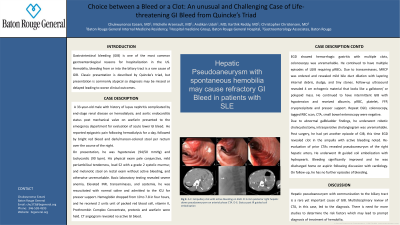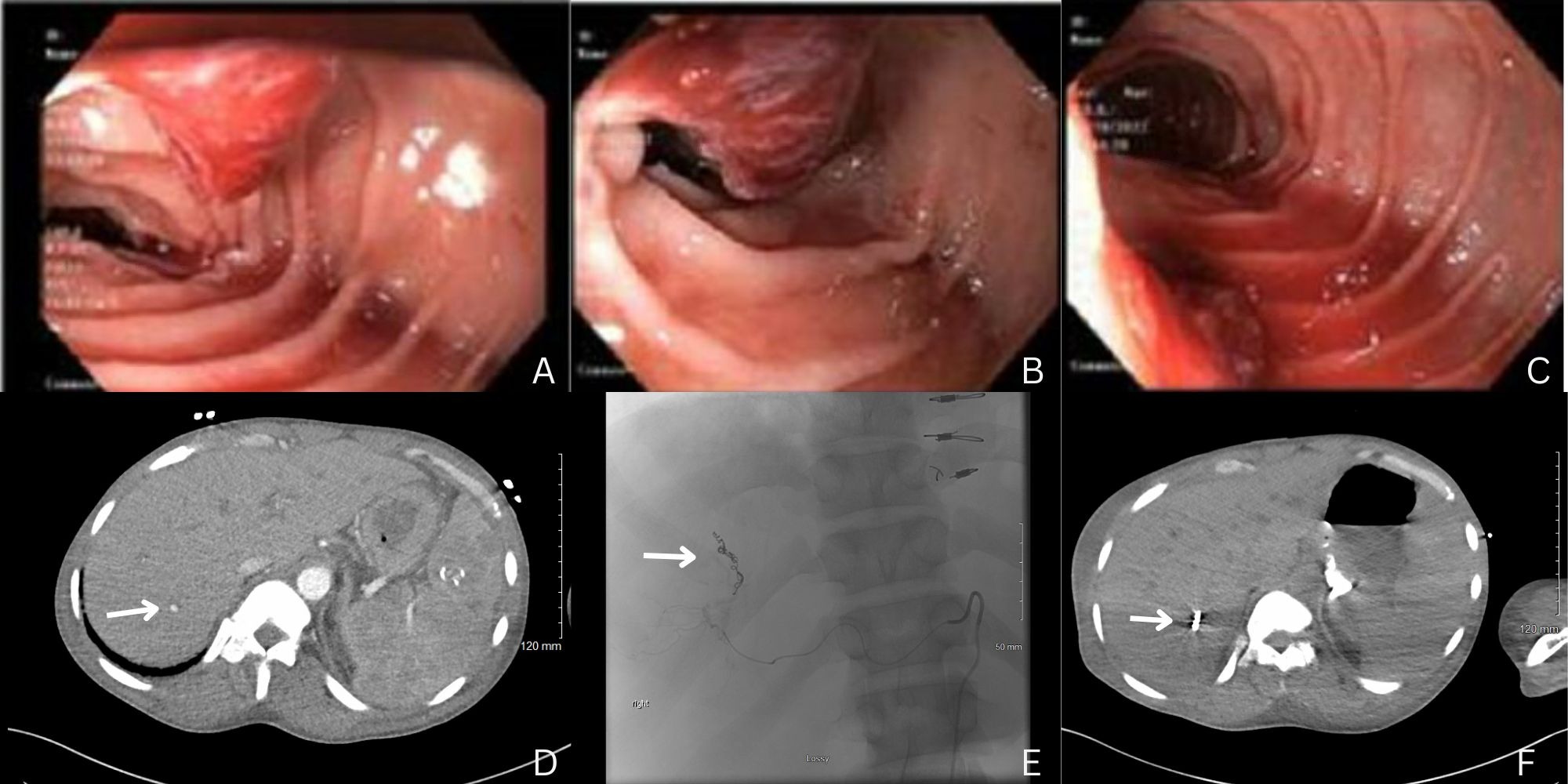Tuesday Poster Session
Category: GI Bleeding
P3498 - Choice Between a Bleed or a Clot: An Unusual and Challenging Case of Life-Threatening Gastrointestinal Bleed From Intrahepatic Pseudoaneurysm Presenting With Atypical Quinke’s Triad
Tuesday, October 24, 2023
10:30 AM - 4:00 PM PT
Location: Exhibit Hall

Has Audio

Chukwunonso B. Ezeani, MBBS
Baton Rouge General Hospital
Baton Rouge, LA
Presenting Author(s)
Chukwunonso B. Ezeani, MBBS1, Michelle B. Arsenault, MD1, Andikan Udoh, MD1, Chidiebube Ugwu, MD2, Karthik Reddy, MD3, Christopher Christensen, FACG4
1Baton Rouge General Hospital, Baton Rouge, LA; 2East Tennessee State University, Johnson City, TN; 3Hospital Medicine Group, Baton Rouge General Medical Center, Baton Rouge, LA; 4Gastroenterology Associates, Baton Rouge, LA
Introduction: Gastrointestinal bleeding (GIB) is a common reason for hospitalization in the US. Hemobilia: bleeding from or into the biliary tract is a rare cause of GIB. Classic presentation is described by Quincke’s triad, but presentation can be atypical so diagnosis may be missed or delayed leading to worse clinical outcomes. We present a 33-year-old with a life-threatening GIB from hemobilia.
Case Description/Methods: A 33-year-old male with history of lupus nephritis and aortic endocarditis, status post mechanical valve on warfarin, presented to the emergency department for evaluation of acute GI bleed. He reported epigastric pain, followed by bright red blood per rectum.
Physical exam was remarkable for hypotension (94/50 mmHg), tachycardia, pale conjunctiva, mild periumbilical tenderness, and melanotic stool on rectal exam without active bleeding.
Laboratory data revealed anemia, Elevated INR, AST, ALT and ALP. He was resuscitated with normal saline and admitted to the ICU for pressor support. Hemoglobin dropped from 10 to 7.8 g/dL in 4 hours, and he received 2 units unit of packed RBC, vitamin K, Prothrombin Complex Concentrate, protonix. Warfarin was held. CT angiogram revealed no active GI bleed. EGD showed hemorrhagic gastritis with multiple clots, colonoscopy was unremarkable. MRCP done due to high transaminases revealed mild bile duct dilation with layering internal debris, and sludge. Follow-up ultrasound revealed 4 cm echogenic material suggestive of a gallstone or polypoid mass.
He continued to have intermittent GIB with hypotension and received albumin, pRBC, platelet, FFP, cryoprecipitate. Repeat EGD, colonoscopy, tagged RBC scan, CTA, small bowel enteroscopy were negative.
Due to MRCP findings, he underwent robotic cholecystectomy; intraoperative cholangiogram was unremarkable. Post-surgery, he had yet another episode of GIB. This time, EGD revealed a clot in the ampulla with active bleeding noted. Re-evaluation of prior CTAs revealed 6mm pseudoaneurysm of the right hepatic artery. He underwent IR-guided coil embolization(A-F). Bleeding significantly stopped and he was discharged home on aspirin following discussion with cardiology. On follow-up, he had no further episodes of bleeding.
Discussion: Hepatic pseudoaneurysm with communication to the biliary tract is a rare yet important cause of GIB. A multidisciplinary review of CTA, in this case, led to the diagnosis. More studies are needed to determine association with SLE which may lead to prompt diagnosis and treatment.

Disclosures:
Chukwunonso B. Ezeani, MBBS1, Michelle B. Arsenault, MD1, Andikan Udoh, MD1, Chidiebube Ugwu, MD2, Karthik Reddy, MD3, Christopher Christensen, FACG4. P3498 - Choice Between a Bleed or a Clot: An Unusual and Challenging Case of Life-Threatening Gastrointestinal Bleed From Intrahepatic Pseudoaneurysm Presenting With Atypical Quinke’s Triad, ACG 2023 Annual Scientific Meeting Abstracts. Vancouver, BC, Canada: American College of Gastroenterology.
1Baton Rouge General Hospital, Baton Rouge, LA; 2East Tennessee State University, Johnson City, TN; 3Hospital Medicine Group, Baton Rouge General Medical Center, Baton Rouge, LA; 4Gastroenterology Associates, Baton Rouge, LA
Introduction: Gastrointestinal bleeding (GIB) is a common reason for hospitalization in the US. Hemobilia: bleeding from or into the biliary tract is a rare cause of GIB. Classic presentation is described by Quincke’s triad, but presentation can be atypical so diagnosis may be missed or delayed leading to worse clinical outcomes. We present a 33-year-old with a life-threatening GIB from hemobilia.
Case Description/Methods: A 33-year-old male with history of lupus nephritis and aortic endocarditis, status post mechanical valve on warfarin, presented to the emergency department for evaluation of acute GI bleed. He reported epigastric pain, followed by bright red blood per rectum.
Physical exam was remarkable for hypotension (94/50 mmHg), tachycardia, pale conjunctiva, mild periumbilical tenderness, and melanotic stool on rectal exam without active bleeding.
Laboratory data revealed anemia, Elevated INR, AST, ALT and ALP. He was resuscitated with normal saline and admitted to the ICU for pressor support. Hemoglobin dropped from 10 to 7.8 g/dL in 4 hours, and he received 2 units unit of packed RBC, vitamin K, Prothrombin Complex Concentrate, protonix. Warfarin was held. CT angiogram revealed no active GI bleed. EGD showed hemorrhagic gastritis with multiple clots, colonoscopy was unremarkable. MRCP done due to high transaminases revealed mild bile duct dilation with layering internal debris, and sludge. Follow-up ultrasound revealed 4 cm echogenic material suggestive of a gallstone or polypoid mass.
He continued to have intermittent GIB with hypotension and received albumin, pRBC, platelet, FFP, cryoprecipitate. Repeat EGD, colonoscopy, tagged RBC scan, CTA, small bowel enteroscopy were negative.
Due to MRCP findings, he underwent robotic cholecystectomy; intraoperative cholangiogram was unremarkable. Post-surgery, he had yet another episode of GIB. This time, EGD revealed a clot in the ampulla with active bleeding noted. Re-evaluation of prior CTAs revealed 6mm pseudoaneurysm of the right hepatic artery. He underwent IR-guided coil embolization(A-F). Bleeding significantly stopped and he was discharged home on aspirin following discussion with cardiology. On follow-up, he had no further episodes of bleeding.
Discussion: Hepatic pseudoaneurysm with communication to the biliary tract is a rare yet important cause of GIB. A multidisciplinary review of CTA, in this case, led to the diagnosis. More studies are needed to determine association with SLE which may lead to prompt diagnosis and treatment.

Figure: A-C: Ampullary clot with active bleeding on EGD. D: 6mm posterior right hepatic dome pseudoaneurysm on arterial phase CTA. D-E: Status post IR-guided coil embolization
Disclosures:
Chukwunonso Ezeani indicated no relevant financial relationships.
Michelle Arsenault indicated no relevant financial relationships.
Andikan Udoh indicated no relevant financial relationships.
Chidiebube Ugwu indicated no relevant financial relationships.
Karthik Reddy indicated no relevant financial relationships.
Christopher Christensen indicated no relevant financial relationships.
Chukwunonso B. Ezeani, MBBS1, Michelle B. Arsenault, MD1, Andikan Udoh, MD1, Chidiebube Ugwu, MD2, Karthik Reddy, MD3, Christopher Christensen, FACG4. P3498 - Choice Between a Bleed or a Clot: An Unusual and Challenging Case of Life-Threatening Gastrointestinal Bleed From Intrahepatic Pseudoaneurysm Presenting With Atypical Quinke’s Triad, ACG 2023 Annual Scientific Meeting Abstracts. Vancouver, BC, Canada: American College of Gastroenterology.
